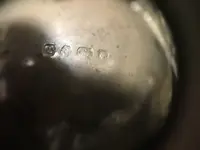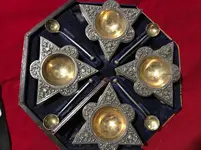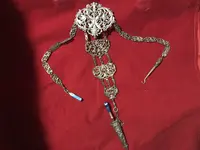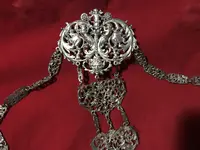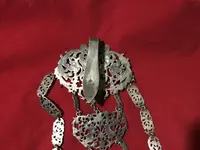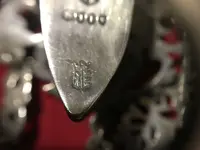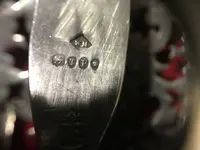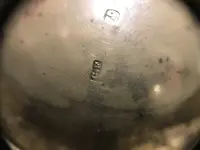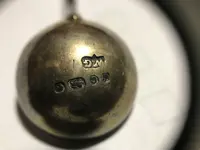You are using an out of date browser. It may not display this or other websites correctly.
You should upgrade or use an alternative browser.
You should upgrade or use an alternative browser.
What are they called
- Thread starter cheech
- Start date
xr7ator
Gold Member
- Joined
- Sep 2, 2011
- Messages
- 5,632
- Reaction score
- 8,134
- Golden Thread
- 0
- Location
- Denver, Colorado
- Detector(s) used
- Garrett AT Pro, AT Gold, ATX, MH7 (oldie!) Minelab Explorer SE Pro, EQ800
Hallmarks.
The second item pictured looks like a chatelaine.
- Joined
- Dec 23, 2019
- Messages
- 6,368
- Reaction score
- 20,258
- Golden Thread
- 0
- Location
- Surrey, UK
- Primary Interest:
- All Treasure Hunting
Very nice pieces.
Both sets of marks are English Sterling silver hallmarks.
The cruet set would have held salt, pepper, mustard (the hot English variety) or other condiments. The hallmarks are slightly indistinct, but they’re for the Sheffield Assay Office and the date letter looks to be a ‘G’ for 1874. It could conceivably be a distorted ‘C’ for 1870.
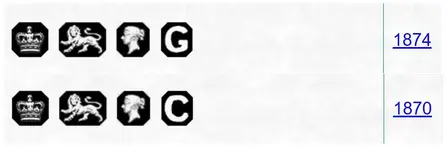
All of the pieces in the set should be similarly marked (except those weighing less than 6 grammes), so perhaps the date letter is a bit clearer on one of the other pieces. You haven’t shown a maker’s (sponsor’s) mark though. Have a closer look to see what you can find. There must be one for the hallmarks to be legal. If there isn’t, then the marks are likely fake and the pieces won’t be Sterling.
The chatelaine is by or from William Moering (registered in London December 1892 and active from 1893-1902). The date letter is ‘T’ for 1894, London Assay Office.


The hallmark set includes the letter ‘F’ in an oval, indicating that this was an imported piece (the ‘F’ denotes ‘Foreign’). Imported pieces could not be sold as silver in Britain unless hallmarked to our standards (even if they had already been hallmarked in another country). It's not possible to say from an import mark where the piece was actually made unless it also has a set of marks for that country.
Both sets of marks are English Sterling silver hallmarks.
The cruet set would have held salt, pepper, mustard (the hot English variety) or other condiments. The hallmarks are slightly indistinct, but they’re for the Sheffield Assay Office and the date letter looks to be a ‘G’ for 1874. It could conceivably be a distorted ‘C’ for 1870.

All of the pieces in the set should be similarly marked (except those weighing less than 6 grammes), so perhaps the date letter is a bit clearer on one of the other pieces. You haven’t shown a maker’s (sponsor’s) mark though. Have a closer look to see what you can find. There must be one for the hallmarks to be legal. If there isn’t, then the marks are likely fake and the pieces won’t be Sterling.
The chatelaine is by or from William Moering (registered in London December 1892 and active from 1893-1902). The date letter is ‘T’ for 1894, London Assay Office.


The hallmark set includes the letter ‘F’ in an oval, indicating that this was an imported piece (the ‘F’ denotes ‘Foreign’). Imported pieces could not be sold as silver in Britain unless hallmarked to our standards (even if they had already been hallmarked in another country). It's not possible to say from an import mark where the piece was actually made unless it also has a set of marks for that country.
Last edited:
cheech
Hero Member
- #6
Thread Owner
Very nice pieces.
Both sets of marks are English Sterling silver hallmarks.
The cruet set would have held salt, pepper, mustard (the hot English variety) or other condiments. The hallmarks are slightly indistinct, but they’re for the Sheffield Assay Office and the date letter looks to be a ‘G’ for 1874. It could conceivably be a distorted ‘C’ for 1870.
View attachment 1869748
All of the pieces in the set should be similarly marked (except those weighing less than 6 grammes), so perhaps the date letter is a bit clearer on one of the other pieces. You haven’t shown a maker’s (sponsor’s) mark though. Have a closer look to see what you can find. There must be one for the hallmarks to be legal. If there isn’t, then the marks are likely fake and the pieces won’t be Sterling.
The chatelaine is by or from William Moering (registered in London December 1892 and active from 1893-1902). The date letter is ‘T’ for 1894, London Assay Office.
View attachment 1869749
View attachment 1869750
The hallmark set includes the letter ‘F’ in an oval, indicating that this was an imported piece (the ‘F’ denotes ‘Foreign’). Imported pieces could not be sold as silver in Britain unless hallmarked to our standards (even if they had already been hallmarked in another country). It's not possible to say from an import mark where the piece was actually made unless it also has a set of marks for that country.
I will check the spoons when I get home thank you for all of that information really helpful
- Joined
- Dec 23, 2019
- Messages
- 6,368
- Reaction score
- 20,258
- Golden Thread
- 0
- Location
- Surrey, UK
- Primary Interest:
- All Treasure Hunting
No worries. Good that there are maker's marks because that validates the pieces as having the full compulsory set of marks. Looks like the set was a composite, perhaps put together and fancily boxed by a high street retailer.
Our records over here are not always complete… sometimes as a result of accidental loss and sometimes as a consequence of German bombing during the war (it wasn’t only London that saw extensive attention from the Luftwaffe) and your marks are uncertain.
The ‘WG’ in shield mark is not reliably attributed but my speculation is that it’s early William Gibson, from before the time he went into business with John Langman in Sheffield and then used the ‘WG over JL’ mark in a similar shield from 1881 onwards.
The ‘C.F’ in chamfered cartouche mark is also uncertain, but here’s a similar piece to yours with the same mark and Sheffield assay for 1870 which is believed to be by Charles Favel of Creswick & Co.
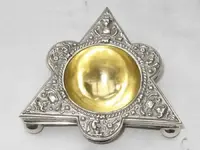
Our records over here are not always complete… sometimes as a result of accidental loss and sometimes as a consequence of German bombing during the war (it wasn’t only London that saw extensive attention from the Luftwaffe) and your marks are uncertain.
The ‘WG’ in shield mark is not reliably attributed but my speculation is that it’s early William Gibson, from before the time he went into business with John Langman in Sheffield and then used the ‘WG over JL’ mark in a similar shield from 1881 onwards.
The ‘C.F’ in chamfered cartouche mark is also uncertain, but here’s a similar piece to yours with the same mark and Sheffield assay for 1870 which is believed to be by Charles Favel of Creswick & Co.

diggummup
Platinum Member
- Joined
- Jul 15, 2004
- Messages
- 17,824
- Reaction score
- 10,135
- Golden Thread
- 0
- Location
- Somewhere in the woods
- Detector(s) used
- Whites M6
- Primary Interest:
- All Treasure Hunting
Two beautiful pieces Cheech.
Similar threads
- Replies
- 4
- Views
- 1K
- Replies
- 11
- Views
- 2K
Users who are viewing this thread
Total: 1 (members: 0, guests: 1)

